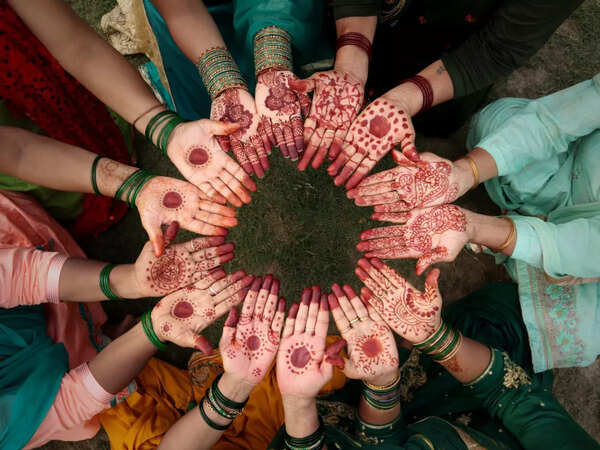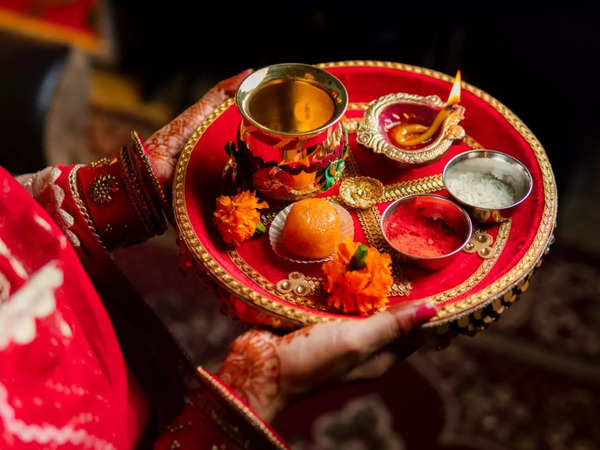Preparation for Karwa Chauth
The preparations for Karwa Chauth begin several days in advance. Married women start shopping for new clothes, accessories, and decorative items. They also apply henna (mehndi) on their hands, often in intricate patterns, as it symbolizes love and dedication.
Fasting
The central ritual of Karwa Chauth is fasting from sunrise to moonrise. Women wake up early, before sunrise, to eat a meal known as “Sargi” that is prepared by their mother-in-law or mother. It typically includes fruits, nuts, and special dishes. After consuming Sargi, women refrain from consuming food and water throughout the day.
Sargi ritual
The Sargi meal holds particular significance as it is believed to bring prosperity and blessings. The mother-in-law presents her daughter-in-law with gifts and blessings for a happy married life. This ritual strengthens the bond between a mother-in-law and a daughter-in-law.
Karwa Chauth fast
Women spend the entire day without eating or drinking, demonstrating their devotion to their husbands. Some women choose to refrain from all kinds of food and water, while others may consume light fruits or liquids to help sustain themselves during the day.
Dressing up

On Karwa Chauth, women often wear traditional attire, like beautiful sarees or lehengas, and adorn themselves with jewellery. Red is considered an auspicious colour, and many women choose to wear red outfits on this day.
Baya or Bayana (gifts)
In some regions, women receive gifts and monetary offerings from their husbands’ families as a symbol of love and appreciation. These gifts are known as “Bayana” and are often given to the woman observing the fast.
Storytelling and songs
Women often gather in groups during the day to share stories, sing songs, and exchange anecdotes about Karwa Chauth. The stories typically revolve around the history and significance of the festival.
Worshipping Karwa Chauth thali
The Karwa Chauth Thali is a special plate that contains all the necessary items for the evening puja (prayer ceremony). It includes an earthen pot (Karwa), a diya (oil lamp), incense sticks, a sieve, sweets, and water. The Thali is beautifully decorated with intricate designs and often passed down from generation to generation.
Breaking the fast

The fast is broken only after sighting the moon. The husband or another elder member of the family accompanies the fasting woman to a designated area where they can see the moon. They often look through a sieve to get their first glimpse of the moon. Once the moon is visible, the woman offers water to the moon and then to her husband. This signifies the successful completion of the fast.
Prayers and pujas
After seeing the moon, women perform a special puja. They light the diya, offer incense, and recite Karwa Chauth vrat katha, which is the story of Queen Veeravati. This story is central to the significance of Karwa Chauth and is believed to be the origin of the tradition.
Exchange of gifts and tokens of love
After the puja, husbands often present their wives with gifts as a token of appreciation for their devotion and love. It’s a heartwarming moment that reinforces the bond between a married couple.
Feasting
Finally, the fast is broken with a meal that often includes various delicacies and special dishes. Friends and family may also join in the celebration, making it a time of togetherness and joy.
Community celebrations
Karwa Chauth is not just observed at the individual level; it is a community celebration. Women often come together in the evening for group prayers and celebrations, which further strengthen the sense of unity and tradition.
Symbolism and significance
Karwa Chauth symbolises love, devotion, and sacrifice in a marriage. It is not just a religious ritual but also a cultural celebration of the bond between husbands and wives. The fasting woman’s prayers and sacrifice are believed to bring health and longevity to her husband.
Evolution and modernisation
While the core rituals of Karwa Chauth remain consistent, the festival has evolved over the years. Modern women often incorporate their own touches, such as using modern utensils instead of earthen pots, and some may choose to break their fast after seeing the moon through a video call if their husband is far away.
